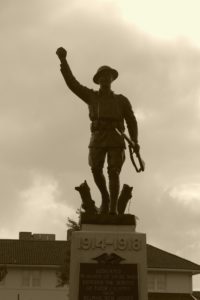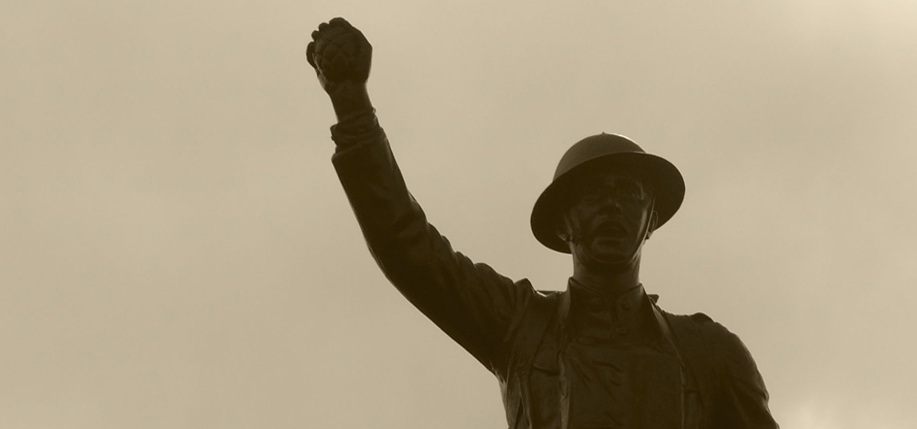Megan Smolenyak delves into the archives and reaches the conclusion that many more Irish-born soldiers were killed in the U.S. Armed Forces in WWI than previous calculations have shown.
As a New Jersey resident with Jersey City Irish roots, I am constantly on the lookout for resources that can assist with Garden State genealogy, so was delighted when I first stumbled across an online database hosted by the State Archives called World War I Deaths: Descriptive Cards and Photographs.¹ Delving into it, I was captivated by the personal stories revealed of the 3,427 men who lost their lives during the First World War, and in many instances, I could gaze at them or read family correspondence as photos and letters were often included.
Some other states have similar databases, but rarely are they as search-friendly as New Jersey’s. In particular, this one has a field that curiously few provide: birth country. With a single inquiry, I was able to learn that 69 Irish-born individuals from New Jersey had died in WWI. The number 69 immediately brought to mind the “Fighting 69th,” the so-called Irish Brigade formed during the Civil War, and perhaps it was that thought that caused me to realize the even greater potential this database offered.
The centenary of World War I has ushered in a growing appreciation for the Irish who gave their lives in the war, but I knew from casual reading that much of the focus has been on those who served under the auspices of Britain and members of the then-Empire, now Commonwealth, such as Australia, Canada and New Zealand. The United States was invariably mentioned, but always given short shrift – a situation which is entirely understandable because records for the other countries are more readily accessible and better lend themselves to scrutiny and analysis.
By contrast, the lion’s share of America’s military personnel records from 1912 to 1960 were destroyed by a fire and associated water damage in 1973, and while other WWI record collections exist, they’re scattered (mostly at the state level) and uneven, both in terms of content and ease of access.
Tripping across this New Jersey gem leveled the playing field, though admittedly just for one state, but might it, I wondered, be possible to extrapolate from it to the national level to arrive at an estimate of native Irish who made the ultimate sacrifice as members of the American armed forces during World War I?
Contributions in Other Countries
I decided to dive in without further scouting as I didn’t want to risk introducing even an unconscious bias regarding the figures that might emerge, but it would be helpful here to share what I later discovered to give a sense of the roles played by the Irish who served in the military of other nations.
My eventual online exploration mostly revealed a fair bit of head-scratching about the United States as I was not the first to wrestle with this question, but the most thorough contemplation of the topic could be found in the work of Irish broadcaster and author Myles Dungan. Drawing from a variety of sources and conducting his own research, he wrote a piece in which he pegged Irish fatalities in the war as follows:²
Canada: 960 (with a caveat that closer study could increase this to as many as 2,000)
Australia: 860 (with a note that careful investigation had increased to this from 488)
New Zealand: 280
South Africa: 80
India: 13
Embarking upon his deliberation of America, he echoed what I had heard elsewhere, remarking, “The U.S.A. is proving, and will continue to prove, most problematic.” But Dungan rose to the challenge and developed a series of assumptions to postulate a figure for the United States of 350, one which he underscored was highly speculative.

New Jersey-based Calculations
Initially and deliberately ignorant of these statistics, I jumped in with my own analysis. I apologize in advance for the number-crunching that’s about to come, but I want to spell out as much of my thought process as possible in the hope that it might provoke additional discussion. Being transparent will allow others to understand how I meandered my way to the outcome I’ll share, and build upon or correct what I have to say, ultimately reaching a more fine-tuned conclusion.
As mentioned previously, my starting point was the fact that 69 Irish-born soldiers from New Jersey had died in WWI. It should be stressed that these 69 were all born in Ireland, and not simply of Irish heritage (in which case, the count would have been substantially higher). Since 3,427 from the state had died, it was simple arithmetic (69/3,427) to determine that the native Irish were 2.01% of the total.
Overall, 116,708 Americans gave their lives in World War I, so if we assume that the percentage of Irish-born from New Jersey who died was fairly consistent across all of the United States, then approximately 2,346 (116,708 x .0201) Irish immigrants died countrywide.
To get a second take on this casualty-derived estimate, I turned to population data. Once again presupposing that the Irish fatality rate for New Jersey was typical across the land, I realized it would be possible to work out a nationwide appraisal, provided I had an idea of what portion of the American
people resided in New Jersey at the time. For this, I consulted the 1920 U.S. Federal Census (as found on Ancestry.com), the one closest to the time of American involvement in the First World War.
The total population at the time was 107,634,003 while New Jersey’s was 3,157,851, so New Jerseyans constituted about 2.93% of the whole. If New Jersey’s experience was indeed representative, then there were roughly 2,355 (69/.0293) deaths in WWI of Irish immigrants across the U.S.
Given that the casualty and population-gleaned sums – 2,346 and 2,355 – are so close, it seems reasonable to use a middle figure of 2,350, but I pondered how I might evaluate the validity of this number. Perhaps it would help, I thought, to introduce another state into the mix as a bit of a check.
New York-based Calculations
I tried out several states, but none offered enough useful information until I investigated New York. While there is a somewhat similar, death-centric collection for New York – Newsday’s New York State’s World War I Dead³ – it is not searchable by place of birth, so there was no easy way to pluck out those born in Ireland. Still, it revealed the critical detail that 13,676 who served from New York died (though it’s suspected that this might be a slight under-accounting).
By examining the New York, Abstracts of World War I Military Service, 1917-1919 database on Ancestry.com, I learned that 514,859 from New York were called to arms. Moreover, it allowed me to search by place of birth, revealing that 9,751 of those who answered the call of duty were born in Ireland.
Dividing 13,676 deaths by the 514,859 who were enlisted gives us a New York-wide fatality rate of 2.66%. If we posit that New Yorkers of Irish birth perished at the same rate as others from the state, 9,751 native Irish serving multiplied by .0266 leads to a ballpark of 259 Irish losses.

New Jersey and New York
Knowing that more data could only help with this conundrum, I decided to combine the counts for New Jersey (69 actual deaths) and New York (259 estimated deaths) to come to an approximation of 328 Irish-born heroes for the two states.
Using population statistics to convert 328 to the national level, I started by adding New York’s figures to those of New Jersey. Earlier, I had determined that New Jersey was home to 2.93% of those in the 1920 census. That same year, New York had 10,402,421 residents or 9.66% of the country’s people, so New Jersey and New York together held 12.6% of the U.S. population in 1920.
If it’s assumed that New Jersey/New York’s blended experience was in keeping with Irish-born fatalities in WWI on a national basis, this leads to a projection in the vicinity of 2,603 (328/.126) Irish deaths for the United States.
Reality Check
So New Jersey-based calculations suggested 2,350 Irish deaths, while combining New Jersey with New York inflated this to about 2,600. These were impressive numbers, but they naturally begged the question of how truly representative New Jersey and New York were for the nation as a whole.
It’s well known that both New Jersey and New York were popular destinations for Irish immigrants, so this nagged at me. Was the Irish-density in this pair of states sufficient to seriously skew my estimates? To address this question, it was necessary to somehow measure the “Irishness” of New Jersey and New York.
In an attempt to develop a barometer of sorts, I turned once again to the 1920 census and found that there were 1,060,294 residents who had begun life in Ireland. Of those, 289,172 were in New York and another 67,335 in New Jersey, for a total of 356,507. While New Jersey and New York contained 12.6% of the overall U.S. populace, they apparently accounted for about a third (33.6%) of the native Irish in the entire country.
Clearly, New Jersey and New York were significantly more Irish than most states, so if their “Irishness” is factored in, extrapolating from the reasonably solid 328 deaths for Irish-born in New Jersey and New York leads to an estimate of 976 fatalities (328/.336) for America, and while that’s considerably less than the earlier tally of 2,350-2,600, it’s also far more than widely thought.

Additional Complexities
There are, of course, other complexities to be mulled. Is it possible that certain states had higher fatality rates than others, and if so, would this apply to New Jersey or New York? Are there important differences in casualty counting among World War I combatants that need to be somehow incorporated or reconciled? Would using the 1910 census be more appropriate, and if so, how would that affect the math?
With regard to this last matter, I had played with 1910 data and was interested to note a drop-off in the percentage of Irish-born in the United States between 1910 and 1920, and then realized that I was observing the fading of Famine-era emigrants such as my own great-great-grandmother who was still alive in New Jersey, but only because she lived to 96. Irish were continuing to come, but not at the same pace as before. Still, I didn’t think that this would have had much impact on those I was researching, men of military service age, so opted for the 1920 census, but some might feel otherwise.
Yet Another Counting Challenge
Having arrived at a conclusion of 976, I now permitted myself to look for what others had said, eventually finding my way to Myles Dungan’s thoughtful ruminations and speculation of 350. While there’s plenty of room for debate and tweaking, I suspect that 976 is closer to the truth, if only because I had the luxury of starting from actual casualty data (albeit at the state level), while Dungan, seeking a nationwide source, had started from draft registration data, making several assumptions to come to his conjecture of Irish lives lost.
Obviously, only a fraction of those who registered for the draft actually served and many volunteered, but setting aside the matter of having to accommodate this reality, there’s a hidden issue concerning World War I draft databases. Dungan used the one at Ancestry.com, but there’s another housed at FamilySearch.org. Since they’re both based on the same collection of draft cards, they should be very similar even though they’re independently transcribed, but querying both by entering “Ireland” in the birth location field results in a count of 57,453 on Ancestry and 85,075 on FamilySearch.
Seeking the source of this unexpected discrepancy, I experimented with both and discovered that Ancestry has 25,467 more from Great Britain than Family-Search, while FamilySearch has 27,622 more from Ireland than Ancestry, so I suspect that the main factor involved may have been differences in instructions to indexers. In short, Ancestry has many of Irish nativity masked by a designation of Great Britain.
Dungan’s starting point of 65,025 (he had typed “Ireland” in the keyword field) split the difference between the two, but even so, was about 31% lower than FamilySearch which seems to be the most accurate. Using his own methodology, adjusting for this difference alone would bring his estimate to 459, which closes the gap, but also highlights the potential pitfalls that can lurk in the databases we often turn to.
New Names for the Roll of Honour

In spite of these measurement complications, I believe that 976 is a fair reckoning for men of Irish birth who gave their lives in service to the United States in World War I. The true figure may be 900 or 1,000, but it’s likely somewhere in this neighborhood.◊ This is more than previously thought, but consensus probably isn’t far off, and it’s worth aiming for.
What is certain is that there are names missing from the Irish National War Memorial (INWM) records. In fact, when I searched the almost 50,000 people included§, I could confirm only one of the 69 from the New Jersey database that sparked this inquiry. Acknowledging the sacrifice of the other 68 sons and brothers by adding them to the INWM Roll of Honour would be a fitting and well-timed contribution to on-going centenary commemorations, and remind us all that there are still more to be accounted for. ♦
_______________
¹ New Jersey resource which sparked this analysis and furnished photos, letters and service summary cards for soldiers: “Department of Defense, Adjutant General’s Office: World War I, Information Cards and Photographs of New Jersey Men Who died in Service, 1917-1918,” held by the New Jersey State Archives, Dept. of State, in Trenton, https://wwwnet1.state.nj.us/DOS/Admin/ArchivesDBPortal/WWICards.aspx
² http://mylesdungan.com/tag/irish-dead-in-the-american-army-ww1
³ http://data.newsday.com/long-island/data/history/world-war-i-deaths
◊ The one caveat I would offer is that this counts deaths from disease, many of which occurred stateside. Some might debate their inclusion even though they sometimes stemmed from injuries or circumstances abroad. While it could be argued that all deaths resulting from military service during wartime should be included, this factor can become an apples and oranges issue when comparing casualty figures with those of other countries.
§ Ireland’s Memorial Record: World War 1 1914-1918: http://search.findmypast.com/search-world-records/irelands-memorial-record-world-war-1-1914-1918


Very interesting article. As I watch the St. Patrick’s Day parade from New York.
Wish I could find information on my father who served in WW1.
I have information if you email me I will pass it on aslong it not a scam
Wish I could find more information.
Way cool! Some very valid points! I appreciate you writing this write-up and also the
rest of the website is very good.